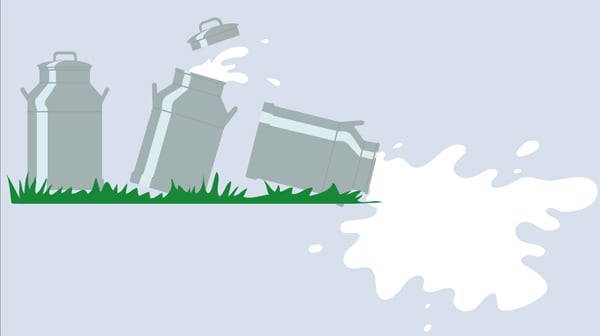Amul's Non Co-operative Movement
Infighting at the top, a stalled AGM, and a possible loss of the brand Amul are not the only troubles facing GCMMF. Now the leadership crisis at the milk co-operative is making some take a relook at the model
The Gujarat Co-operative Milk Marketing Federation (GCMMF) and brand Amul was, till recently, seen as a glittering example of what a producers’ collective could actually do.
Co-operatives, which combine the commercial orientation of a for-profit enterprise with a service to the community, work on the assumption that if a producer’s collective is set up with pay offs that reward the producers, then their self-interest ensures that it will function as an effective economic organisation. However, the months-long power struggle at GCMMF raises questions on whether the assumption of self-interest is indeed true.
Till the time Verghese Kurien was at the helm everything seemed to be moving as per principles. He was no milk producer and in that sense did not have a ‘self-interest’ in the success of the organisation. However he espoused the cause of milk producers almost like a chief executive who was appointed to do a job that was assigned to him. GCMMF was also able to prevent the State from taking over individual units. GCMMF never looked vulnerable because it was run professionally and in an orderly manner. There was no scandal that tainted the organisation, and hence no scope for anybody to touch it.
How a system that ran smoothly and grew into a phenomenon could show cracks in a matter of a few years indicates the fragility of the co-operative form of organisation. It also raises some doubts on whether it is indeed a credible alternative to the market model.
Checks and Balances
Suddenly the glue that held the structures together seems to be wearing out. The people at the helm of affairs do not seem to be representing the interests of the milk producers. In a similar situation, with a crisis in the leadership of a for-profit firm, there would have been an attempt at takeover from somebody who thought that it was possible to provide better management and thus better value to the shareholders. The institution of stock market also helps. There would have been enough signals in the market that would have predicted this situation and the movement would have happened early on.
Unfortunately, the co-operative structure does not have an exchange where supply rights could be traded. Change can happen only through the mechanism of a board room or a general body meeting or through the intervention of the state. There could be no market action that could build a tempo for such a change.
Structural Issues
GCMMF’s organisational structure too has something to do with the crisis. Unlike the sugar co-operatives which are a single-tier structure (with the cane producer directly voting for the board of the sugar processing unit), GCMMF is a federal unit with a three-tiered structure operating on a representational democracy. The village level co-operatives (which procure milk from the members, the dairy farmers) elect members to the district union (which transports and processes the milk); the district unions elect members to the federation, whose role is to market, provide strategic planning and investment — these are the people who sit on the board of GCMMF. At the primary level, voting is on a one member one vote basis, whereas at the federal level the votes that a person commands is proportional to the business interests his/her institution represents. The membership [and thus the ownership] could theoretically be transient — only milk producer pourers (the dairy farmers) could be voting members of the milk co-operative and their capital contribution is incidental. Therefore, if they were to exit from the co-operative, the cost to them would at best be the loss of an assured buyer for the product. At exit, there is no exit bonus and for entry into a co-operative there is no entry load or premium. This is an invitation for free-riders.
A brand built and nurtured over a period of 50 years is showing cracks at the hands of a dozen board members who may not behave in a responsible manner. These board members have only an upside with limited downside. They actually lose no capital, no loss if they lose a source that procures the milk that is produced. The ones who would shed tears at the fall of the brand would be those whose livelihood depends on the payments received from the milk co-operative. That somebody is far removed — at least three tiers away — from the machinations.

Surprisingly the State has shown restraint in case of GCMMF. However, what are the rights of a milk pourer member at this time? When does his or her opportunity [even theoretically] come to change the management or give a signal to the elected management? Is there a single block of shareholders/members who could influence the way the organisation functions?
Unfortunately the answer to these questions is in the negative.
The question then is whether this is a problem with the basic structure of co-operatives or something to do with the tiered structure of milk co-operatives. When we look at the sugar co-operatives which have been designed to achieve almost total alignment — the rights of using the facilities [crushing capacity] with the amount of resources one is able to command [acreage under sugarcane] with the capital contribution [a share is equal to a certain acreage of supply] and the membership being restricted [providing for informal entry load and exit premiums] — it seems to be working. In case of milk co-operatives the insularity was provided by a strong leadership that was committed to the cause. However, given the tiered structure, there is a danger of the federal brand losing its sheen and the components of the federation declaring independence [as Mehsana Milk Union had threatened in the past].
While the co-operative form in itself is an important organisational form, it needs to be tweaked to factor the opportunistic behaviour of the leaders. If there is an effective way of handling logistics and decentralising the processing capacities, and there is no reason why we should not have single-tiered large co-operatives designed in a way that maintains the centrality. Over a period the corporate world has shown that “self-interest” of a dominant block of shareholders does not necessarily ensure great governance and therefore if there is a significant learning from the corporate world it certainly should be in ensuring the interests of small shareholders [or dairy farmers] through the process of independent persons on the governance structure. In all these years Kurien provided that independence of thought to the food major. It is time now that the interests of the dairy farmers are protected not only by those who pour milk, but possibly by those who do not, but are capable of providing management support.
The author is an adjunct professor at the Indian Institute of Management, Ahmedabad.
(This story appears in the 10 September, 2010 issue of Forbes India. To visit our Archives, click here.)















